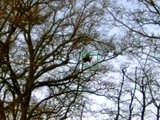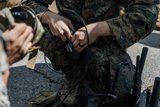Dstl working on CIRCE project
A joint mission to launch miniature sensors that will advance space weather measurement and modelling capabilities is being carried out by the Defence Science and Technology Laboratory (Dstl) and the US Naval Research Laboratory (NRL).
The project, called the Coordinated Ionospheric Reconstruction Cubesat Experiment (CIRCE), comprises two 6U cube-satellites that will be launched into a near-polar a low earth orbit of 500km altitude this year. Each 6U satellite bus measures 10cm x 20cm x 30cm, and will carry almost identical instrument capability.
The UK contribution to CIRCE is the Insitu and Remote Ionospheric Sensing suite, which will complement NRL sensors, comprising three highly miniaturised payloads developed for Dstl by University College London, University of Bath, and University of Surrey/Surrey Satellite Technology. CIRCE will characterise a region of the space environment, the ionosphere, which is important for a range of defence and civil applications and can impact GPS, communications and sensing technology.
Miniaturisation of space weather sensors means that a significant capability is packed into each satellite. This type of miniaturisation could pave the way for deployment of many more sensors, and routine inclusion on other satellites thanks to their small size, weight and power. The result would expand data collection for the near-Earth space environment, and enhance space weather modelling capabilities.
More from Digital Battlespace
-
![EID to unveil new vehicle communication system at DSEI]()
EID to unveil new vehicle communication system at DSEI
The Portuguese company’s naval communications system is in service across more than a dozen countries. It has turned to its home nation for support in developing a new vehicle based C2 system.
-
![Chess Dynamics successfully demonstrates Vision4ce AI-driven tracker]()
Chess Dynamics successfully demonstrates Vision4ce AI-driven tracker
The Vision4ce Deep Embedded Feature Tracking (DEFT) technology software is designed to process video and images by blending traditional computer vision with artificial intelligence (AI) algorithms to present actionable information from complex environments.
-
![Wave Relay devices cleared for security use on commercial systems in industry trend]()
Wave Relay devices cleared for security use on commercial systems in industry trend
Persistent Systems has been cleared by National Security Agency (NSA) to transmit sensitive data on commercial networks. The devices are added to the NSA’s Commercial Solutions for Classified (CSfC) component list which also includes other companies’ products providing the same security.
-
![UK teases cyber spending boost in Strategic Defence Review ahead of “imminent” release]()
UK teases cyber spending boost in Strategic Defence Review ahead of “imminent” release
The release of the UK’s Strategic Defence Review (SDR) has been long promised as mid-year. It is possible it could be as early as 2 June although the UK Ministry of Defence (MoD) continues to play its cards close to its chest.
-
![Intelsat emphasises SATCOM resilience for SOF in contested domains (video)]()
Intelsat emphasises SATCOM resilience for SOF in contested domains (video)
Intelsat outlines how its multi-orbit SATCOM architecture is enhancing connectivity and resilience for special operations forces operating in degraded and contested environments.
-
![US Space Force’s next-generation missile warning system moves forward with $500 million in new contracts]()
US Space Force’s next-generation missile warning system moves forward with $500 million in new contracts
Next-Generation Overhead Persistent Infrared (Next-Gen OPIR) satellites are intended to provide early warning of missile launches from any location worldwide and new ground stations will result in expanded coverage of critical missile warning.























